Using scrubbing to rejuvenate facial skin is commonplace these days. At home, you can use various store-bought scrubs, or salt and ground coffee. The result obtained from this procedure will be short-lived. There is another alternative - chemical peeling.
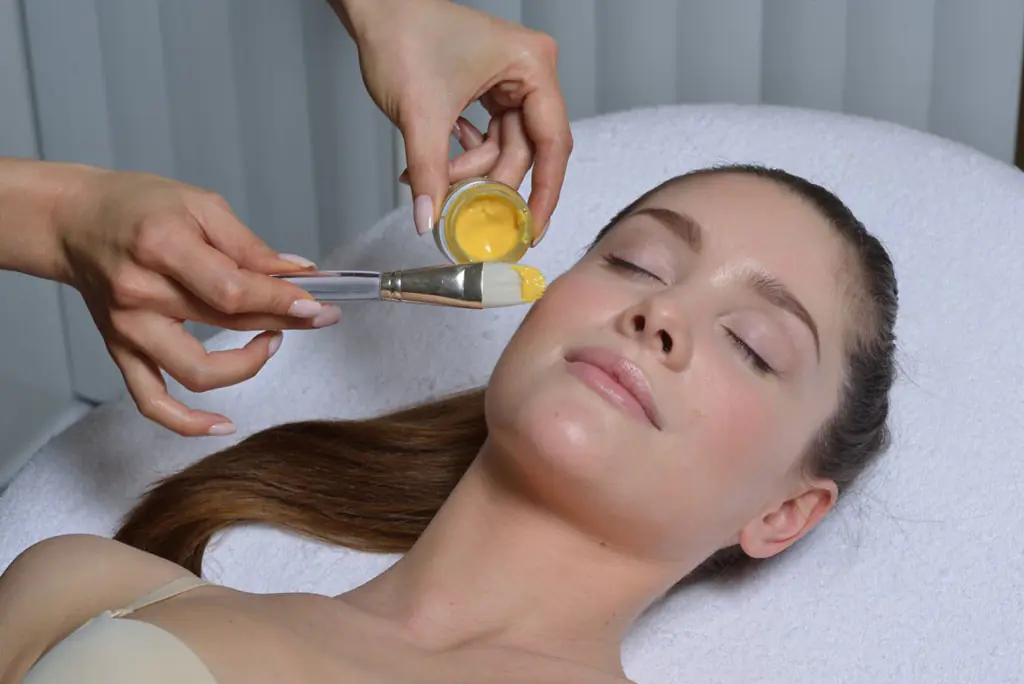
Chemical peeling - what is it?
This is primarily a salon procedure. Because it involves burning layers of skin with acids. These substances act on the skin, destroying its cells. Due to this, the face peels off greatly, and after the “old skin” falls off, we get new, smooth skin with a noticeable reduction in wrinkles.
When choosing a suitable chemical peel, keep in mind that there are three types:
- Affecting only the surface of the skin.
- Affecting the middle layers of the skin
- Deep.
Care after chemical peeling
When carrying out any type of chemical peeling, it is necessary to stock up on panthenol and products (cream, gel) with antioxidant properties. In the first few days, it is advisable to use products with a light, foaming structure, for example Panthenol spray, and only then switch to creams.
Basic rules for facial care after chemical peeling:
- Rest your skin. Literally: in the first 1-2 days, no washing gels, ultraviolet radiation, and especially no scrubs. Also limit touching your skin. There may be a film on it, do not peel it off under any circumstances.
- Don't use homemade masks. In everything related to facial care, it is better to listen to a cosmetologist.
- After the procedure, you should not sunbathe for a long time. The skin is very delicate and sensitive, and it is forbidden to injure it in this way. Therefore, precede any exit to the street by applying sunscreen.
Special rules
When using phenolic acids, be prepared to take antibiotics. This procedure is the most painful and deep.
Skin protection from the sun during deep peeling should also be extreme. You will have to protect your face from the sun's rays and use strong sunscreen throughout your life.
Retinoic peeling - what is it?
A retinoic peel is a chemical exfoliation that targets the middle layers of the skin. It contains analogues of vitamin A, and it has a more gentle effect on the skin. It is also called a yellow peel because the cream containing retinoids is a bright yellow shade.
Retinoic yellow peeling allows you to quickly renew your skin. The face becomes younger before our eyes, minor defects are removed - wrinkles, potholes, unevenness. The face becomes bright and velvety.
Care after yellow peeling
The yellow peeling procedure entails some discomfort. First of all, of course, you need to take a sick leave or a week's leave, since your face will be red and irritated after the procedure.
The slightly frightening appearance is also accompanied by painful sensations. The skin becomes tight, and when peeling, it itches noticeably.
Caring for after retinoic peeling is not difficult, the main thing is to have patience. For the first couple of days, you should leave your face alone, only lightly washing your face is allowed.
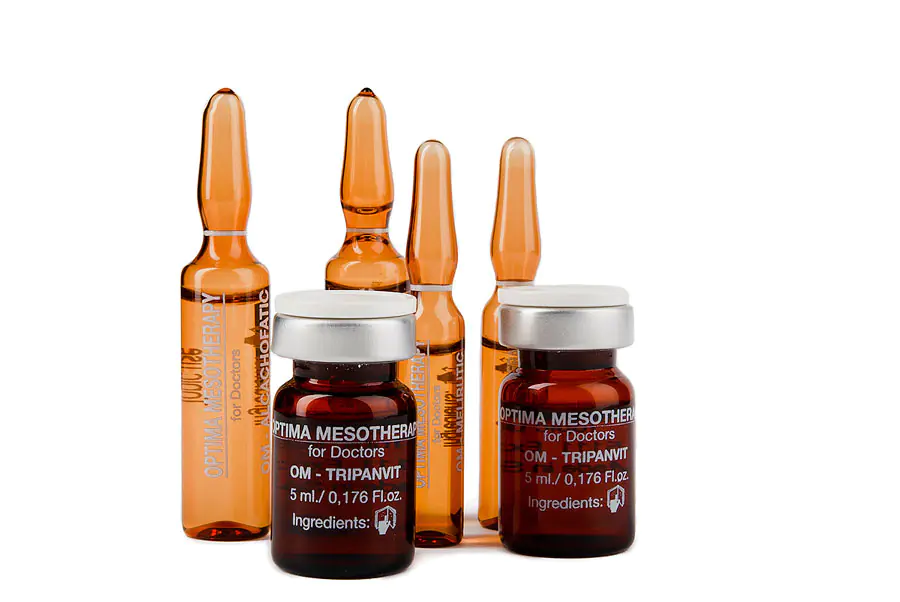
For the next two days, the skin will be very tight, and its surface will be reddish and shiny. To get rid of discomfort, you can apply a thick layer of Panthenol to your face for 15-20 minutes, then carefully remove with napkins. This mask can be applied up to 8 times a day, depending on how it feels. Instead of panthenol, it is also allowed to use other anti-inflammatory balms, such as borage, fireweed and shea oils. You can start using gel or milk for washing, but without scrubbing particles.
Peeling will disappear 10 or 12 days after the procedure, and redness after two weeks. To speed up the process, you can apply a mask to your face, which will contain lactic acids and cranberry extract. It will gently help your face cleanse faster. At the end of this period, you can use regular cleansers and makeup removers.
Since the course of exfoliating procedures ranges from 1 to 6 visits to a cosmetologist, with a break of 1.5-2 months, be patient and stock up on Panthenol.
Between treatments, carefully monitor your makeup and facial products. They should not contain retinoids or AHAs for at least two weeks after the procedure. It is also highly recommended not to color your hair.
By secret
- You missed your classmates' reunion because you're afraid to hear that you've grown old.
- And you catch the admiring glances of men less and less often.
- Advertised skin care products don't refresh your face as much as they used to.
- And the reflection in the mirror increasingly reminds us of age.
- Do you think you look older than your age?
- Or you just want to “preserve” your youth for many years.
- You desperately don't want to grow old and are ready to take any opportunity to do so.
Just yesterday no one had a chance to regain youth without plastic surgery, but today it has appeared!
Follow the link and find out how you managed to stop aging and restore the freshness of your skin.
Yellow peeling, which in cosmetology is called retinoic peeling, is a special procedure. It can replace modern creams, masks and other expensive products that help preserve youth for a long time. The article presents real reviews about retinoic peeling, photos before and after the procedure, as well as the stages of its implementation. This information will definitely be useful to modern girls and women who want to look better.
The essence and types of the procedure
Retinoic peeling is a procedure aimed at removing excess skin cells using special products. Today there are three types of peeling:
- Deep. A serious procedure in which the drug affects both living and dead cells.
- Average. The components of the drug penetrate deep into the skin.
- Surface. Eliminates dead parts of cells.

Peeling is called yellow, because after applying the composition to the surface of the facial skin, it acquires a yellowish tint. There is no need to be afraid of such an effect, because it is only a temporary phenomenon. The procedure is called retinol or retinoic peeling in connection with the main active component of the product - retinoic acid.
Experienced cosmetologists often call peeling a weekend procedure. It received this name due to the fact that patients will need exactly two days to recover. Experts strongly recommend going for a session on Friday so that by Monday your skin will be completely back to normal.
Expected Result
Most often, reviews from cosmetologists about retinoic peeling indicate that after the procedure the patient’s face looks much better. Thanks to the retinoids included in the composition, the following changes occur:
- wrinkles become less noticeable;
- blood circulation improves;
- the skin is cleansed of bacteria;
- the humidity level is normalized;
- a healthy glow appears.
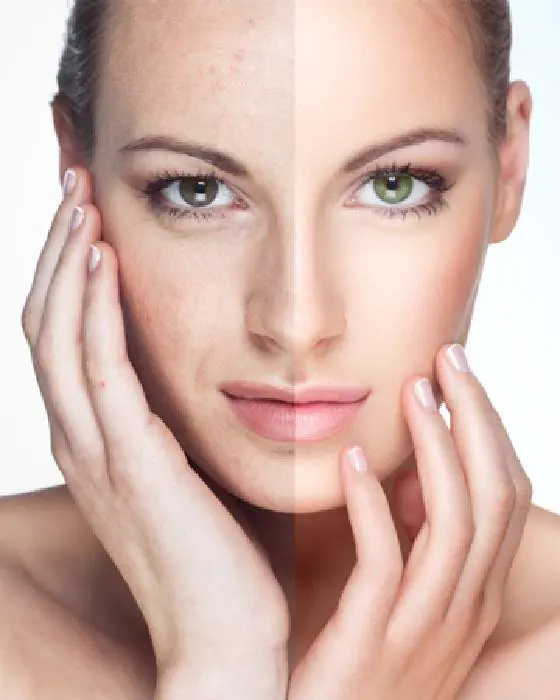
You can achieve these results quite easily, because a couple of sessions will be enough for this. The break between them should be exactly one and a half months. It is worth noting that the final result directly depends on the initial condition and characteristics of the skin.
The peeling contains various acids, each of which has its own unique properties:
- phytic acid is designed to fight emerging inflammatory processes;
- Koyaeva is able to destroy dead cells and reduce melanin levels;
- ascorbic acid (vitamin C) helps slow down the aging of the skin;
- azelaic acid perfectly regulates the functioning of the sebaceous glands, eliminates age spots and acne.
Who needs peeling?
The procedure is intended for those with mature skin. It is for this reason that older women most often leave reviews about retinoic peeling. Photos before and after the session make it clear that the procedure is truly effective and worthy of attention.
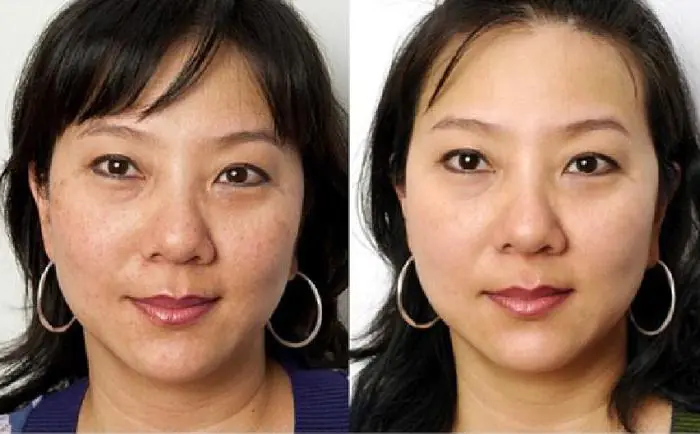
As a rule, patients aged 35-50 years turn to peeling. For younger women, the procedure will be useful in the following cases:
- overly rich and bright pigmentation;
- many pimples and blackheads;
- too strong activity of the sebaceous glands;
- pronounced acne scars;
- first destructive skin changes;
- skin diseases.
Advantages
Due to the large number of advantages, people most often leave positive reviews about retinoic peeling. The before and after photos presented in the article are a good example of how incredible results can be achieved.
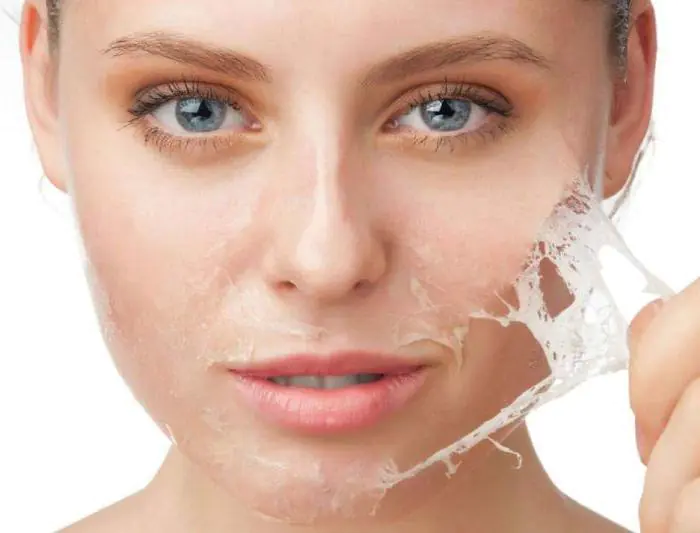
The main advantages of peeling include:
- Safety. In its component composition, retinoic acid is similar to vitamin A. Based on this, there is no need to worry about the human body’s reaction to it. The mixture also contains some other acids that can enhance the effect of retinoic acid, which is the active ingredient.
- Delicate impact. Yellow peeling is rightfully considered one of the most gentle, so there are no obstacles to achieving noticeable results.
- Efficiency. Most specialists begin rejuvenating the skin of their patients with this procedure. In some cases, the effect of a couple of sessions is equal to 10 procedures with glycolic acid. The resulting effect lasts quite a long time – up to 4 months.
- Fast recovery. The face after retinoic peeling, of course, will peel and turn red, but all these problems go away very quickly. For final restoration of the skin, no more than two days are needed.
Preparing for the session
Before skin rejuvenation, certain preparation for retinoic peeling is required. First of all, the specialist determines the type and condition of the skin, the tendency to allergies, as well as the presence of various ailments that may interfere with peeling. Immediately after this, the client is prescribed certain creams, which must be used for several weeks in a row. Most often, these products are based on glycolic acid. Thanks to them, the skin softens, which allows retinoids to easily penetrate to a greater depth. In the absence of proper preparation, the effect of the procedure may be several times less.
Retinol peeling requires avoiding tanning salons, using exfoliants, and long-term sun exposure. During the week before the procedure itself, you should remove yourself from all this so as not to damage the skin.
Carrying out the procedure
The first thing you need to do is cleanse your face of decorative cosmetics. Immediately after this, the skin is treated with a solution consisting of salicylic and glycolic acids. This helps remove dead cells. As soon as the solution begins to interact with the skin, it is cleansed. During this, the client may feel a slight burning sensation, which will go away in just 4-7 minutes.
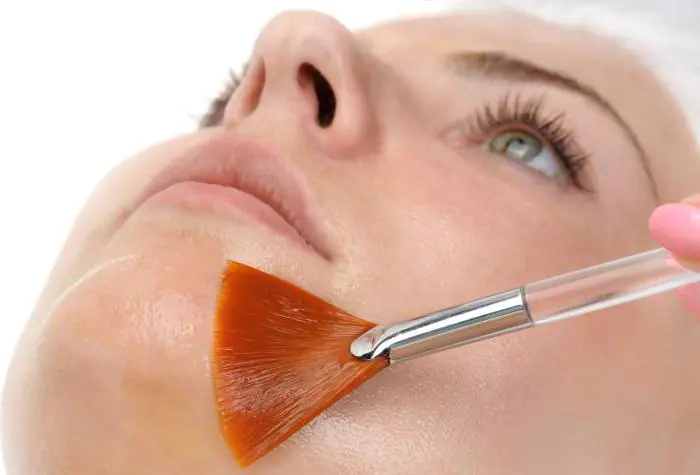
The next step is to apply the composition to the face. This mask can be kept on from 15 minutes to as long as 12 hours. The holding time is determined based on the desired result. After this, the product is thoroughly washed off under running water, and then a protective cream is applied to the skin and evenly distributed.
Consequences and contraindications
Contraindications and complications of retinoic peeling are of interest to all people who decide to undergo such a procedure for the first time. In this case, everything happens as usual: slight redness, itching, peeling and swelling appear. All this goes away quite quickly, so you will be able to enjoy the results very soon.
Complications after the procedure can only arise if it was performed with a low-quality composition or in the absence of proper preparation. Skin irritation or inflammation may occur. If they do not go away on their own for a long time, then you should definitely contact a specialist as soon as possible.
Peeling is not recommended for pregnant women or nursing mothers. In addition, cosmetologists prohibit performing the procedure for people who have:
- recent tanning;
- allergic reaction to vitamin C;
- active herpes;
- damage to the skin to which the composition must be applied;
- severe illness;
- individual intolerance to certain components.
Such people can replace the retinoic procedure with laser or ultrasound peeling. They also have the opportunity to turn to diamond microdermabrasion.
Skin care after peeling
The rehabilitation period does not last that long, but during this time it is necessary to take proper care after retinoic peeling. As you know, during recovery you feel severe dryness and tightness of the skin. After some time, a crust appears on the surface of the face, which under no circumstances should be removed. After a few hours it will go away on its own; if it is disturbed, complications may arise. Many reviews about retinoic peeling (photos before and after are below) say that when the crust is peeled off, scars, pimples, and age spots appear, which are not as easy to get rid of as it seems at first glance. Therefore, women who have already dealt with a similar problem are strongly recommended not to touch this layer.
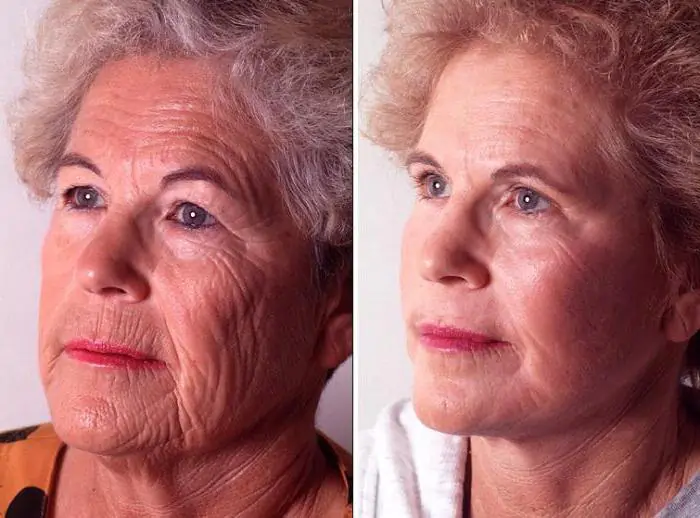
During rehabilitation, it is necessary to regularly use special means. They are prescribed by the specialist who performed the procedure, because he knows all the characteristics of his patients’ skin, and can also determine which products will help restore and not worsen the condition of the skin. When going for a walk under the scorching sun, you need to wear a classic wide-brimmed hat that will cover your face from the direct rays of the sun. In addition, you should first apply sunscreen to your face, thereby protecting yourself from the adverse effects of ultraviolet rays, which pose a particular danger during recovery.
Retinoic peeling itself is a safe procedure. In isolated cases, after a session, patients experience increased acne, which can only be treated by an experienced specialist. This side effect doesn't just happen. The main reasons are neglect of personal hygiene or contraindications. Therefore, in order to protect yourself from such consequences, you need to properly care for your facial skin not only after each procedure, but also use regular moisturizing and cleansing creams, lotions and other cosmetics daily.
Cost of the procedure
For people interested in skin rejuvenation, the price of retinoic peeling becomes relevant. Today, specialists in various salons perform the procedure for only 4-6 thousand rubles per session. For those with normal skin, for which two sessions are enough, paying for peeling will not be difficult. But those who require a course of treatment consisting of 4 procedures will have to spend a considerable amount of money.
The price of retinoic peeling is acceptable to many clients. For this money they get an incredible effect that they cannot achieve on their own.
Peeling with retinoic ointment at home
Conventional drugs containing retinoic acid are freely sold in pharmacies. You can buy them without a prescription. That is, buying a special ointment and using it at home will not be difficult.
The recipe for retinoic peeling at home is quite simple. To carry out the procedure yourself, you need to stock up on the following components:
- moisturizing cream;
- retinoic ointment;
- a tablespoon of water;
- glycolic cream;
- teaspoon of soda.
Many people are interested in how to do retinoic peeling at home, because this procedure will be several times cheaper than in a salon. In fact, there is nothing complicated about it. It is performed in several steps:
- cleansing the face of decorative cosmetics and wiping with a paper towel;
- applying and evenly distributing cream with glycolic acid over the surface of the face;
- skin treatment with a retinoic agent;
- applying a neutralizing mixture consisting of soda and water (45 minutes after the ointment);
- after 7 hours, rinse off the composition with warm water;
- moisturize the skin with regular cream.
As mentioned above, a slight burning sensation may be felt on the skin during the procedure. There is no cause for concern, since such a reaction only means that the composition reacts with the skin and the beginning of the process of cleansing and rejuvenation.
Immediately after the session, peeling begins. When performing peeling at home, it can last a little more than two days, but no more than a week. Under no circumstances should you manually assist natural exfoliation. This nuance must be taken into account, as there is a risk of damaging the skin. The best way to combat peeling during this period is frequent moisturizing with special products.
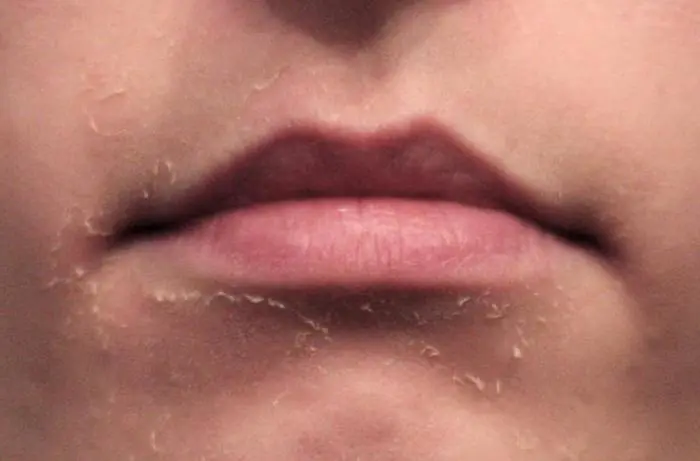
In the first days after peeling, redness will appear. They can only last a day or two. The skin will completely heal and recover within a week after the session.
You can secure a long-lasting effect by repeating the cleansing three times. That is, it is necessary to carry out the procedure once every three weeks, and then repeat the procedure again after six months.
Reviews
The opinion of patients regarding retinoic (yellow) peeling most often boils down to the fact that it is as effective and painless as possible. Many women who decide to undergo the procedure like to conduct various experiments with their skin without fear of an unpleasant result. After the peeling, they experienced only enthusiastic emotions, since they simply did not expect such an amazing effect.
Despite the cost of the session, which may seem high to some people, patients do not mind paying that kind of money for a peeling that will lift their spirits for a long time. Due to the fact that the procedure copes with several problems simultaneously, women are happy to turn to it and do not regret it in the future.
It is almost impossible to encounter negative reviews about it, since everyone is happy with the result obtained and has nothing against the means used to achieve it. Only a small part of women indicate some negative aspects in their reviews. The most common of these is a burning sensation felt during cleansing. At the same time, some people are unhappy that after the procedure they have to refrain from direct sunlight, which is quite difficult to do in the summer season.
We'll tell you what retinoic peeling is, what makes it unique, why it's called yellow, and why those who are under eighteen love it.
- What is retinoic peeling
- Types of retinoic peeling for the face
- How is peeling done?
- How to care for your skin after a retinoic peel
- Precautionary measures
- Tips and reviews from cosmetologists
What is retinoic peeling
Like any peeling, retinoic peeling is aimed at renewing the skin and improving the appearance of the skin. But it has a number of features that fundamentally distinguish it from its “colleagues”, be it acid, mechanical or hardware versions of peeling. What is its unusualness and why is it called “peeling from the inside”?
Composition and mechanism of action
The main component is retinoic acid. It stimulates the growth and proliferation of keratinocytes, accelerates cellular renewal. It also turns the product yellow. To make it easier to understand how retinoids work with skin cells, let's compare them with their main competitors - fruit acids, for example, glycolic acid. Its goal is to damage the stratum corneum of the skin, resulting in the exfoliation of old cells and their replacement with new ones. Retinoids act differently: they do not destroy anything, moreover, they do not work directly at all either with the cells of the stratum corneum or with intercellular structures.
Retinoic peel is a yellow mask © Getty Images
The target of retinoids is not the surface of the epidermis, but the deeper basal layer in which cells originate. Being small lipophilic molecules, retinoids easily reach their destination and significantly accelerate the division of keratinocytes, or, more simply, the formation of new cells. Young keratinocytes en masse begin to move upward, to the surface of the skin, and literally push out the overlying layers. Hence the effect of exfoliation and renewal.
Retinoic peeling does not destroy dead structures, but stimulates living ones by contacting cell nuclei through special receptors. Moreover, retinoic acid interacts not only with keratinocytes, but also with fibroblasts and melanocytes, improving the condition of the skin in several indicators, including density, elasticity and uniformity of pigmentation.
In addition to retinoic acid itself, the peeling preparation includes auxiliary components, mainly acids, that can enhance one or another cosmetic effect. For example:
whitening: Fetinic, kojic, azeloic acids;
exfoliation: salicylic acid;
fight against free radicals: vitamin C;
calming and anti-stress effect: allantoin, aloe and chamomile extracts.
Indications for use: who will need it and when?
The abilities of retinoic peeling are multifaceted. In addition to standard indications for peelings, including dullness, increased greasiness, uneven surface, retinoic acid works with age-related skin changes, such as:
thickening of the stratum corneum.
Therefore, the majority of fans of retinoic peeling are women who have crossed the forty-year mark.
Skin with acne (not in the inflammatory stage!) and post-acne phenomena also respond well to the effects of retinoids.
Efficiency
Like any peeling, retinoic peeling is done in a course. Although the result in the form of fresh, renewed, radiant, smooth skin can be noticed after the first session. The final effect depends on the number of procedures, the concentration of the chemical agent, and the peeling application regimen. As a result, you can achieve:
smoothing superficial wrinkles and reducing deep ones;
lightening or complete disappearance of age spots;
even out skin texture and tone;
skin tightening and light lifting.
How often can you do it
Types of retinoic peeling for the face
Among cosmetologists and patients, retinoic peeling is known as “Yellow Peel”. The fact is that retinoic acid, like all synthetic analogues of vitamin A, has a bright yellow or orange color - hence the name.
The composition of the peel and the concentration of the main substance vary depending on the specific preparation and manufacturer. Typically, professional Yellow Peel contains 5-10% retinoic acid.
Retinoic acid gives the peel its yellow color © Getty Images
As for the usual classification of peelings (superficial, medium, deep), in the case of retinoids it is very arbitrary. Strictly speaking, retinoic peeling cannot be superficial, since it only works in the deep basal layer of the epidermis. However, with Yellow Peel you can achieve:
medium and medium-deep peeling, renewing all layers of the epidermis.
There is a type of retinoic peeling that works only to tighten the skin turgor and does not cause peeling at all.
How is peeling done?
Preparation
Two weeks before the “yellow peeling”, start using products with acids in your home care. This will help your skin clear the way for retinoids to penetrate into the deeper layers. Usually, special cosmetics are recommended by a cosmetologist. We provide examples of products that meet the requirements of pre-peeling preparation.
Two-stage peeling Visionnaire Crescendo, Lancôme consists of two parts, each of which is designed for two weeks of use. The first phase, just the preparatory phase, includes a low concentration of fruit acids and quinoa husk extract. These substances provide easy exfoliation and accustom the skin to the active action of peeling agents.
Cleansing toner for mature skin against imperfections Blemish & Age Solution, SkinCeuticals Suitable for preparing skin for salon peeling. Contains glycolic, salicylic and capryloyl-salicylic acids for gradual gentle exfoliation.
Night peeling that activates skin radiance, Idéalia, Vichy The formula contains glycolic acid 4% + Hepes 5%, as well as antioxidant blueberry extract. Renews skin and enhances its radiance with fermented black tea extract.
Carrying out the procedure
Before applying the yellow peel, the skin is cleansed and treated with an acid-based lotion to loosen the stratum corneum and facilitate the penetration of retinoic acid.
The peeling itself is a yellow cream mask, which is applied in a thin layer to the entire face (including the skin around the eyes) or to individual areas using rubbing movements. This ends the mandatory stages of the protocol - further options are possible.
Peeling can be tolerated on the face 15-20 minutes, and then rinse with a solution with neutral pH.
Maybe repeated (and repeated) application and rinsing of retinoic peeling during one session.
Another option: leave the mask on for six hours, and then the “yellow-faced” patient goes home and washes off the composition on his own.
The procedure is painless, the maximum discomfort is a slight tingling sensation and a feeling of warmth.
Retinoic peeling solves the problems of aging and young skin © Getty Images
How to care for your skin after a retinoic peel
The rehabilitation period after a procedure with a moderate effect (that is, causing active peeling and renewal of the skin) takes an average of a week.
A feeling of tightness occurs on the 2nd day.
Peeling begins on the 4th day after peeling.
Please note: superficial peeling does not cause discomfort and violent peeling, but the effect of such peeling is less expressive.
During the post-peeling period, you will need cosmetics that meet special requirements. The main one is the complete absence of acids in the composition.
Rules for skin care after peeling
Washing with gel-like products that do not contain aggressive surfactants and oils. Our recommendation - cleaning micellar gel for face and eyelids Rosaliac Gel, La Roche-Posay, , which contains hyaluronic acid in its composition, provides comfort and freshness when washing.
Care including products with the function of protecting and restoring the skin barrier. They need to be applied several times a day for 3–5 days after peeling.
Mandatory sun protection with maximum SPF.
We recommend a restorative soothing agent La Roche-Posay - Cicaplast balm SPF 50 with madecassoside for better skin regeneration and panthenol for a calming effect and restoration of the protective mantle. The solar screen and the prokerad component provide prevention of post-peeling pigmentation.
Precautionary measures
Yellow peeling reduces the skin's immunity, making it susceptible to infections. Often, an exacerbation of herpes occurs as a side effect. Usually cosmetologists prescribe special medications before peeling to prevent this reaction.
Retinoids in high concentrations cause large-plate peeling. Plus, the manifestation of retinoic dermatitis in certain areas of the skin is considered normal, which manifests itself:
Usually these troubles go away on their own after the rehabilitation period.
Tips and reviews from cosmetologists
Medical Expert Vichy Elena Eliseeva believes: “Retinoic peeling is a safe and effective procedure.” Below we list its main advantages.
Relatively fast recovery period. Cosmetologists often call it a weekend procedure: if you peel on Friday, your face will return to normal by Monday.
Retinoic peeling is optimal not only for general skin renewal and rejuvenation, but also for targeted correction of hyperpigmentation.
It is carried out in a shorter course, on average 4–5 procedures are enough.
This procedure is contraindicated during pregnancy and lactation; for liver diseases; during the season of active ultraviolet radiation (and in the case of already developed tanning). Contraindications also include damage to the epidermis (due to dermatological diseases or as a result of banal squeezing of pimples).



